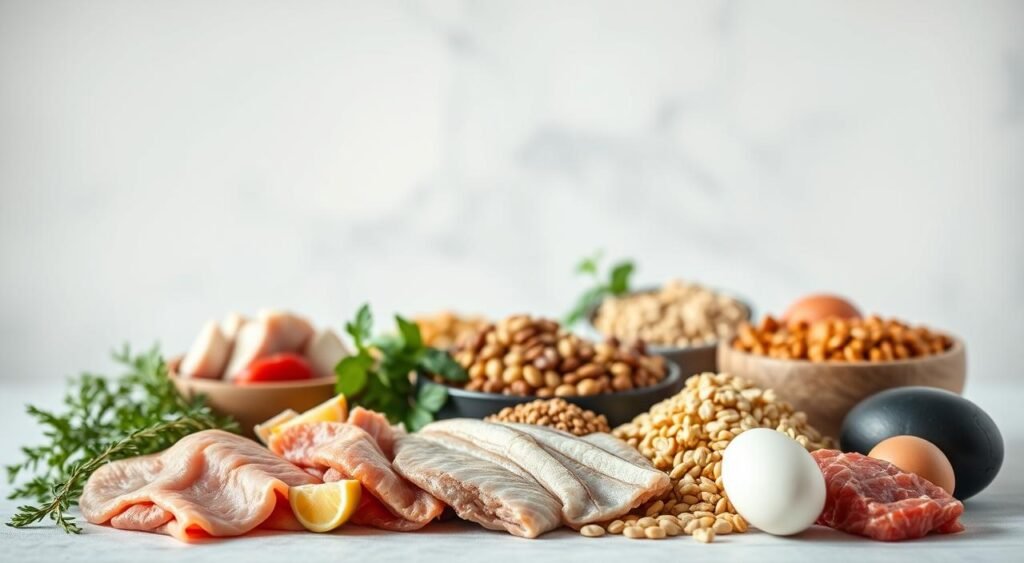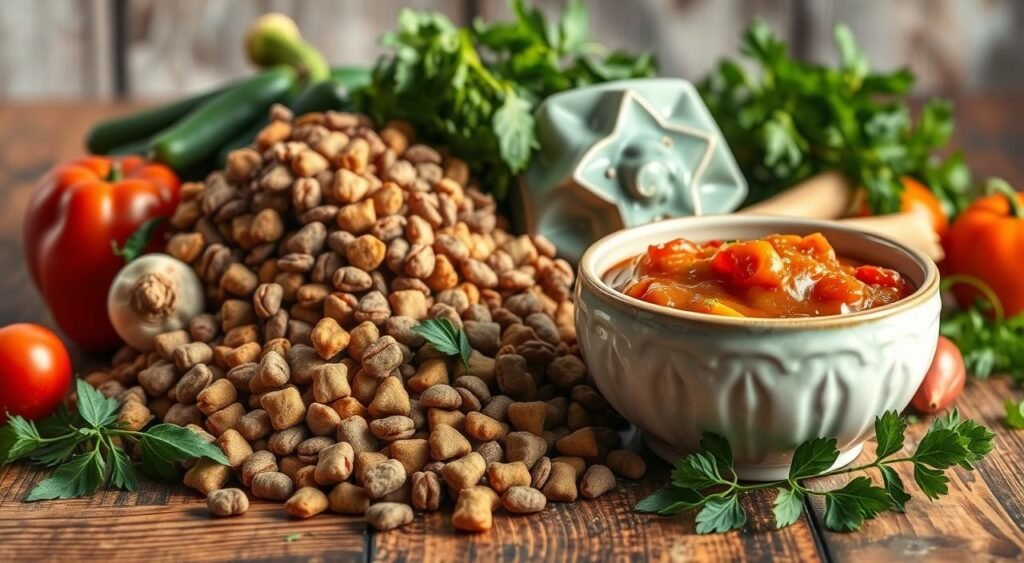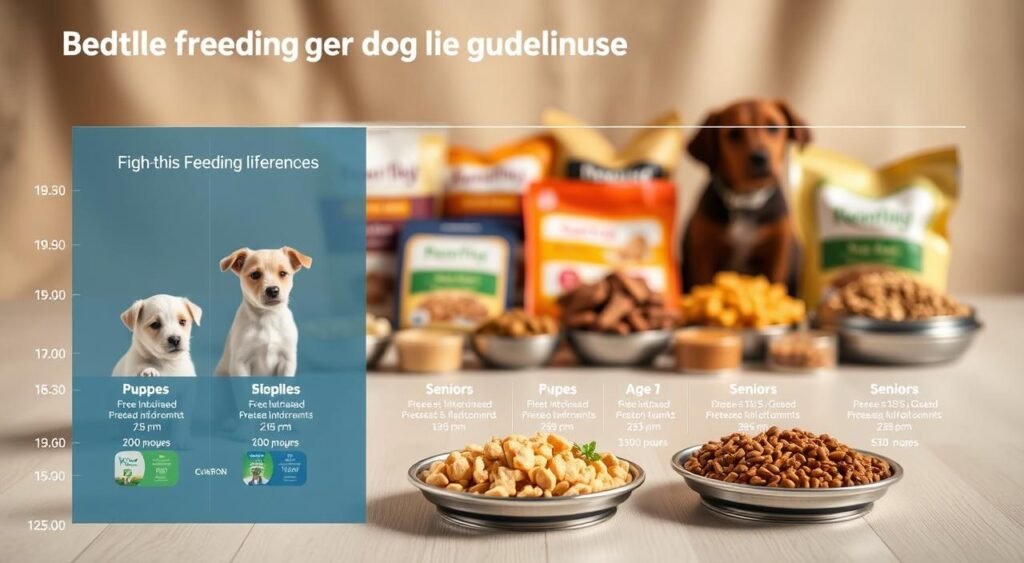Did you know that 60% of dog owners don’t know what their pets need to eat based on their age, breed, or how active they are1? More than half of U.S. dogs are too heavy, which can lead to diabetes and joint issues1. But, 80% of pet owners say their dogs’ coats look better and they have more energy after using supplements like beetroot or pumpkin powder2.
Feeding your dog right is more than just filling a bowl. It’s the key to their long-term health. A diet full of proteins, antioxidants, and fats can make dogs live 2-5 years longer1. However, only 40% of owners make sure their dogs get enough exercise, and only 30% keep them mentally sharp with puzzle toys1. This guide will help you understand what your dog needs to be at their best, from reading labels to adjusting their diet as they grow.
Key Takeaways
- 60% of owners lack knowledge of their dog’s specific dietary requirements1.
- Over 50% of U.S. dogs are overweight or obese1.
- 80% of dogs develop dental disease by age three without proper care1.
- 70% of dogs benefit from mental stimulation toys to prevent boredom1.
- 80% of pet owners see improvements in health with supplements like pumpkin powder2.
Understanding Dog Nutrition: The Foundation of Canine Health
Every dog’s health begins with balanced meals for dogs that include proteins, fats, vitamins, and minerals. These nutrients are crucial for energy, growth, and immunity3. The Association of American Feed Control Officials (AAFCO) makes sure dog foods meet these standards3
Early nutritional management can reduce diabetes and obesity risks, according to studies3.
Puppies need more calories and nutrients during their first months of rapid growth3. By 12–24 months, most dogs shift to adult formulas. Active breeds burn more calories, so portions should adjust with their energy use3. Senior dogs lack universal dietary standards, so regular vet checkups are key3.
Avoid toxic foods like grapes, onions, or raisins—these can cause severe health issues3. Always introduce new foods slowly. The National Research Council’s guidelines help tailor diets based on life stages and activity levels4.
Key nutrients work like this: proteins build muscles, fats nourish skin, carbs provide energy, and vitamins/minerals support immunity4. Cook veggies like carrots before serving, but skip high-risk foods3.
The Science Behind Dog Nutrition: What Your Canine Companion Needs

Understanding dog nutrition begins with the science of their dietary needs. Each meal is a blend of nutrients that fuel energy, growth, and immunity. Dogs do best when their meals match their biological needs, not ours.
Macronutrients vs. Micronutrients in Your Dog’s Diet
Proteins, fats, and carbs are macronutrients, needed in large amounts. Puppy diets need 25–30% protein5 for fast growth. Fats give energy, and carbs provide quick energy. Micronutrients like vitamins and minerals are crucial for organ health, even though they’re needed in smaller amounts. Dogs can’t digest many human foods, making their dog nutrition unique.
How a Dog’s Nutritional Needs Differ from Humans
Puppies need twice as many calories as adults5. Their short digestive systems can’t handle onions or chocolate safely. Foods like grapes are toxic. Always check labels to avoid mistakes.
The Role of Nutrition in Preventing Common Health Issues
Too many calories can lead to obesity5. High-fiber diets help manage weight. Omega-3s reduce inflammation, and fiber improves digestion. Proper nutrition prevents diabetes and joint problems. Meals should meet AAFCO standards6 to ensure all necessary nutrients are present.
Feeding science is not a guess. Focus on quality ingredients and avoid over-feeding. Your dog’s health relies on this.
Essential Nutrients Every Dog Requires for Optimal Health
For your dog to be healthy, they need the right mix of nutrients. These nutrients help them grow, have energy, and stay well. Let’s look at what your dog needs to stay in top shape.
Proteins and Amino Acids: Proteins are key for muscles, organs, and enzymes. Dogs can’t make 10 amino acids, so they need them in their food7. Foods like chicken, fish, and eggs have all they need. Plant-based proteins might need mixing to get the right balance8.
Healthy Fats: Fats are more than just energy. They protect organs, help the brain, and keep skin healthy. Dogs need omega-3 and omega-6 fatty acids from food, as they can’t make enough. Fish oil and flaxseed are great for this, keeping coats shiny and helping wounds heal7. AAFCO says dogs need 1–2% fat in their diet for vitamin absorption8.
Carbohydrates: Carbs give dogs quick energy and help with digestion. Foods like grains, veggies, and fruits are good sources. Dry foods usually have 30–60% carbs, which is good for the gut and helps with weight8.
Vitamins and Minerals: These tiny nutrients are crucial for immunity and strong bones. Dogs need vitamins A, D, E, and B-complex, along with minerals like calcium and phosphorus7. AAFCO has guidelines, like 5,000 IU/kg of vitamin A, to ensure they get what they need8.
Knowing what your dog needs helps make sure their diet is right. Every meal should have the right mix of nutrients to keep them healthy7.
Protein: The Cornerstone of Your Dog’s Dietary Requirements
Protein is more than just a trend; it’s crucial for your dog’s health. It helps with muscle repair, energy, and overall well-being. Dogs need high-quality proteins like chicken, fish, or eggs for essential amino acids9.
Adult dogs need 18–25% protein in their diet9. Puppies, on the other hand, require up to 29% for growth9. Small breeds might need proteins like salmon or lamb because of their fast metabolism9. Active breeds, such as border collies, may need more protein to keep up with their energy10.
- High-quality proteins help with coat health and immune function.
- Plant-based proteins (e.g., peas, lentils) should supplement, not replace, animal sources9.
- Senior dogs might need adjusted protein levels to support joint health10.

Look for labels saying “complete and balanced” for life stages10. A 10-pound dog needs about 10g of protein daily9. Avoid diets with fillers like corn or soy as main ingredients10. Always talk to a vet for dogs with kidney issues or allergies, as their canine diet may need special protein levels10.
“Protein quality matters more than quantity. Prioritize real meat first,” says the American Kennel Club10.
Remember, protein needs change based on breed, age, and activity. Check labels for guaranteed analysis and talk to your vet to meet your dog’s unique needs910.
Decoding Commercial Dog Food Labels: What You Need to Know
Choosing the right dog food starts with understanding labels. Each ingredient and claim tells you about the food’s quality. Here’s how to read them for better choices.
AAFCO requires nutritional adequacy statements to specify a product’s life stage suitability11.
Guaranteed Analysis: This section shows nutrient percentages. Dry kibble might list 23.3% protein, while canned foods vary11. Foods with higher dry matter values have more concentrated nutrition.
- Protein: Look for minimums over 20% for active breeds.
- Fat: Ensure adequate levels for energy and coat health.
Ingredients List: Ingredients are listed by weight. A product named “Chicken Dog Food” must be 95% chicken12. Avoid generic terms like “meat by-products.”
Marketing Claims: Labels like “Beef Dinner” require 25% beef excluding water12. Terms like “with” require 3% of the named ingredient. “Flavor” claims only need detectable amounts12.
AAFCO Standards: Foods must meet either growth or maintenance nutrient profiles11. Look for “feeding trials” on the AAFCO statement—these prove real-world testing over just lab-formulating11.
Reading labels helps you see if a product meets your dog’s needs. Choose foods that meet AAFCO feeding trials and avoid vague terms. These steps help pick the healthiest dog food for your pup’s life stage.
Dry Kibble vs. Wet Food: Making the Right Choice for Your Pup
Deciding between dry kibble and wet food depends on your dog’s needs. Both have benefits for different lifestyles and health conditions.

| Aspect | Dry Kibble | Wet Food |
|---|---|---|
| Moisture Content | 10% max13 | 78% max13 |
| Cost | Affordable long-term13 | Higher per serving13 |
| Dental Health | Reduces tartar buildup13 | Risk of plaque if uneaten14 |
Wet food is great for keeping dogs hydrated and full14. It’s perfect for older dogs or those with kidney issues. Dry kibble is better for active dogs because it’s cheaper and lasts longer13.
Look for best dog food choices like Hill’s Science Diet® or Royal Canin®. They offer vet-approved formulas in both forms13.
- Moisture needs: Wet food aids hydration (78% moisture)13
- Palatability: Canned options boost appetite in picky eaters14
- Convenience: Kibble stays fresh unrefrigerated13
Many owners mix both types for a good balance. Choose brands that meet AAFCO standards and use real ingredients like Purina Pro Plan®13. Always talk to your vet for dogs with special needs to pick the best food.
Alternative Feeding Approaches: Raw, Homemade, and Specialty Diets
Thinking about canine diet options other than kibble? Raw, homemade, and specialty diets offer flexibility. But, they need careful planning to ensure balanced meals for dogs. Without expert help, nutritional gaps are common.
The Raw Food Diet: Benefits, Risks, and Best Practices
Raw diets aim to mimic how dogs ate in the wild. They focus on fresh meat, bones, and veggies. Yet, 90.9% of these diets lack enough selenium, and 63.6% are low in zinc15.
Handling raw food improperly can lead to bacterial risks like Salmonella. Always talk to a vet before starting a raw diet, especially for puppies or dogs with weak immune systems.
Homemade Dog Food: Ensuring Nutritional Balance
Homemade meals let you pick what goes into your dog’s food. But, 90% of homemade recipes lack important nutrients like taurine or balanced amino acids16. Without a vet’s help, your dog might face long-term health problems.
Use trusted resources like the World Small Animal Veterinary Association’s guidelines to avoid mistakes16.
Prescription and Therapeutic Diets: When Are They Necessary?
Specialty diets are for dogs with specific health needs like kidney disease or allergies. These diets follow strict AAFCO standards, ensuring the right nutrient mix. For example, 6 out of 11 tested products failed to meet Ca:P ratios, showing why vet-formulated diets are key for sick pets15.
Always get your vet’s advice when choosing these specialized diets.
Feeding Guidelines Through Life Stages: Puppies to Seniors
Adjusting dog nutrition to match life stages ensures pets thrive at every age. Proper dietary requirements for dogs change as they grow, recover, or age. Start with a quality food listing real meat first, avoiding fillers. 
| Life Stage | Nutrient Focus | Meal Tips |
|---|---|---|
| Puppies | 22-32% protein, 10-25% fat17 | 4–6 meals/day until 8 weeks17 |
| Adults | AAFCO-approved balance17 | Use formula: 30 × weight (kg) +70 for daily calories17 |
| Seniors | Lower calories, higher protein17 | Include omega-3s and glucosamine17 |
| Pregnant/Nursing | 50% extra calories by pregnancy end18 | Lactatinging dogs need 2–4x calories18 |
Puppy Nutrition: Building a Strong Foundation
Puppies need 22–32% protein and 10–25% fat17. Feed them 4–6 meals daily until they are 8 weeks old. Then, reduce to 2–3 meals after 6 months17. Large breeds need special formulas to avoid growth issues17.
Adult Dog Nutrition: Maintaining Peak Health
Adults need diets that meet AAFCO standards. Use the formula 30 × weight (kg) +70 to calculate daily calories17. Active dogs may need more, while less active pets require portion control to avoid obesity.
Senior Dog Nutrition: Adaptingation for Aging
Seniors often need 10–30% fewer calories but higher protein17. Look for diets with glucosamine, omega-3s, and antioxidants. Reduce portions by 10–30% if activity slows17.
Special Considerations for Pregnant and Nursing Dogs
Pregnant dogs need 50% more calories by pregnancy’s end18. Nursing dogs require 2–4x calories; a 10-lb nursing cat needs 600 cal/day18. Consult a vet for precise adjustments.
How to Calculate Your Dog’s Daily Food Portions for Optimal Health
Over 59% of dogs in the US face obesity risks from overfeeding19. Keeping your dog healthy starts with the right amount of food. First, check your dog’s body condition score (BCS) on a 1–9 scale. A score of 5 is perfect20.
Here’s a 3-step plan:
- Calculate resting energy requirement (RER) using: RER = 30*(weight in kg) + 70
- Adjust for activity: Sedentary multiply by 1.2, active by 2.
- Convert calories to cups using your dog food’s calorie density. For example, Purina Pro Plan dry food’s 400 calories/cup means a 18-lb dog (8.2kg) needing 400 calories/day would get 1 cup daily19.
Use guidelines from brands like Blue Buffalo. For example, 4-mo to 6-month puppies need 2.5–4¼ cups daily19. Treats should never be more than 10% of total calories20. Don’t free-feed—split meals into 2-3 for better digestion21.
Check your dog’s weight every 2–4 weeks and adjust food portions. A dog’s needs can vary up to 50% from average guidelines19. Always talk to your vet for personalized advice to keep your pet healthy for life.
Creating an Effective Feeding Schedule for Your Four-Legged Friend
A consistent feeding schedule is key to a canine diet that supports health and behavior. Timing is as important as nutrition. Let’s explore how to structure daily routines for your pet’s well-being.
Free Feeding vs. Scheduled Meals: Pros and Cons
- Scheduled meals offer better portion control and let you track appetite changes. Puppies benefit most from this routine, needing 3-4 meals daily to manage small stomachs22.
- Free feeding risks obesity and orthopedic issues in young dogs, as ad libitum access leads to overeating22. Most adult dogs thrive on 2 meals per day23.

Feeding Frequency by Life Stage
Puppies under 12 weeks need 4 meals daily, reducing to 3 meals by 3-6 months, then 2 meals as adults23. Senior dogs may benefit from smaller, more frequent meals to aid digestion. Always follow balanced meals for dogs guidelines on food labels.
Timing Meals Around Exercise and Sleep
Wait at least 1 hour after feeding before exercise to avoid bloat risks22. Morning and evening meals align with most owners’ schedules. Consistent meal times also help with potty training, as dogs often eliminate 30 minutes post-meal23.
Stick to AAFCO-approved formulas and adjust portions for spayed/neutered dogs, who need fewer calories23. Treats should never exceed 10% of daily calories23.
Common Food Allergies and Sensitivities: Spotting and Addressing Problems
Understanding food allergies in dogs is key to their pet health. Signs like itching, ear infections, or upset stomachs might mean they’re reacting to foods like chicken, beef, or wheat24. These foods cause an immune response, unlike other digestive problems24.
Look for early signs: scratching, red skin, or diarrhea could mean a problem25. Beef, dairy, and eggs are common culprits25. A vet will suggest an elimination diet to figure out the cause. This means feeding only one protein and carb source for 8–12 weeks24, then adding back old foods to see how they react25.
To manage allergies, you must avoid the foods that cause them. Here are some ways:
- Hydrolyzed diets break down proteins to prevent immune reactions25,
- Novel protein diets use unique ingredients like venison or kangaroo25,
- Prescription foods are safe and avoid cross-contamination risks25.
Don’t use over-the-counter “limited-ingredient” foods without vet approval25. Work with your vet to pick healthy dog food that’s right for your dog. Regular vet visits help keep their diet on track24.
Weight Management: Strategies for Preventing Canine Obesity
Keeping your dog at a healthy weight is key to their health. Yet, over 50% of dogs in the U.S. are overweight26. This can shorten their life by up to two years and increase the risk of diabetes and joint disease26. Start by checking your dog’s body condition score, which should be between 4-527.
Breeds like Labradors or Beagles are at higher risk. They need special dog nutrition plans27.

- Reduce daily food by 10% if keeping current diet, then monitor progress27.
- Opt for high-protein, high-fiber diets—like those with green beans or pumpkin—to boost satiety27.
- Limit treats to 10% of daily calories; swap high-calorie snacks for carrots or cucumbers28.
Start by adding 10% more walking time each week. Begin with 20-minute walks and gradually increase to brisk walks26. For dogs with arthritis, hydrotherapy or swimming can help reduce joint strain26. Weigh your dog monthly to see if they’re losing weight. If not, adjust their meals or activity26. Always talk to a vet before changing their diet, especially if they’re prone to metabolic issues28.
“Exercise and diet must balance for lasting results. Consistency prevents rebound weight gain.”26
Use grams to track meals and avoid overfeeding28. Divide their daily food into 4-6 portions to help control hunger28. A structured plan can help most dogs reach their weight goals in 6-8 months26. Remember, make changes slowly to avoid health problems26.
Dietary Supplements: When to Add Them to Your Dog’s Nutrition Plan
While essential nutrients for dogs are best found in a balanced diet, supplements can help in certain situations. For instance, older dogs with arthritis might benefit from glucosamine and chondroitin to ease joint pain. This is because about 20% of older dogs have arthritis29. Always talk to a vet before adding any supplement to ensure it’s safe.
- Omega-3 fatty acids (salmon oil) support skin/coat health and reduce inflammation29.
- Probiotics aid digestion post-antibiotics or for sensitive stomachs30.
- Glucosamine/chondroitin help manage joint issues like hip dysplasia2930.
“Supplements should never replace a complete diet but enhance it when needed.”
| Supplement | Benefit | Best For |
|---|---|---|
| Omega-3 | Joint/skin health | All life stages |
| Glucosamine | Joint support | Seniors with arthritis |
| Probiotics | Digestive balance | Puppies/sensitive stomachs |
Choose supplements from brands with the NASC seal (National Animal Supplement Council)30. Stay away from human supplements with xylitol or too much vitamins, as they can be harmful30. Over 1.9 billion USD is spent globally on pet supplements each year, but quality can vary a lot31. Always get a vet’s advice to avoid giving too much of minerals like calcium, which can harm young puppies30.
A well-formulated diet usually covers all essential nutrients for dogs. Supplements are for specific needs, not to replace a good diet. Choose supplements backed by studies, like omega-3 for heart health or SAM-e for liver support30.
Conclusion: Nurturing Your Dog’s Health Through Proper Nutrition
Every dog needs a diet that fits their unique needs. Start by choosing best dog food choices based on their age, activity level, and health32. A balanced diet with 20-25% protein from quality sources like poultry or fish helps build strong muscles and gives energy32. Add 14% healthy fats for a shiny coat and 61-66% carbohydrates for lasting energy32.
These numbers are more than guidelines—they’re the keys to a longer, healthier life for your pet33.
Always check labels for AAFCO compliance and avoid too much corn or soy33. Look for brands like Royal Canin Veterinary Diet or Purina Pro Plan Sensitive Skin & Stomach for dogs with allergies or digestion issues32. For seniors over 7 years, consider wet food or warming meals to improve appetite32. Puppies need 3-4 meals daily, while adults do well with 2-3 portions split evenly32.
Regular vet consultations ensure diets stay aligned with life stage changes34. Overweight dogs should follow diets with higher protein, lower fat, and fewer calories than maintenance levels32. Remember, 30 x (weight in kg) +70 calculates daily calories for adults—adjust this as they age32.
A holistic approach combines quality dog nutrition with exercise and vet care34. Small steps like reading labels or adjusting portions today can prevent costly health issues tomorrow. Your choices now shape their vitality for years to come—because a well-fed dog is a happy, energetic companion ready for many adventures34.
FAQ
What are the essential nutrients my dog needs for a balanced diet?
How can I determine the best dog food for my pet?
How often should I feed my dog?
What are common food allergies or sensitivities in dogs, and how can I manage them?
Why is protein important in my dog’s diet?
How do I read dog food labels effectively?
Are homemade diets beneficial for my dog?
What are the risks of dog obesity and how can I prevent it?
Should I consider supplements for my dog?
How can I create a feeding plan tailored to my dog’s specific needs?
Source Links
- The Ultimate Guide to Keeping Your Dog Healthy and Happy – https://awardog.com/blogs/bully-sticks/the-ultimate-guide-to-keeping-your-dog-healthy-and-happy?srsltid=AfmBOorTZMTXIMSuLCxTw47JEG-lAEBEhUXGPVe5Kqx-0MkvffGKdApT
- The Ultimate Guide to Our Canine Supplement Range: Tail-Wagging Nutrit – https://snackwaggers.co.uk/blogs/the-naturals-blog/the-ultimate-guide-to-our-canine-supplement-range-tail-wagging-nutrition-for-your-furry-friend?srsltid=AfmBOoqNiyvKiF9OverzCmPCEfhs04avBKdu1d-1OM8Zje8RMnJ0KOvo
- Understanding Your Dog’s Nutritional Needs for Different Life Stages – https://www.geniusvets.com/pet-care/learn/dogs/dog-nutrition/blog/understanding-your-dogs-nutritional-needs-different-life
- Nutrition – Canine Welfare Science – https://caninewelfare.centers.purdue.edu/health/nutrition/
- Dog Nutrition – https://www.johnsonanimalclinic.com/services/dogs/dog-nutrition
- The Science Of Dog Nutrition & Dog Happiness – https://glencadiagourmet.com/blog/science-of-dog-happiness-dog-nutrition/?srsltid=AfmBOopao1ZB9n92571PUD3Ip_ni3HAzt4Gk21Hd4LpYZc_wX6UWB1X0
- The Facts About Dog Nutrition – https://www.webmd.com/pets/dogs/dog-nutrition
- Dog Nutrition: Guide to Dog Food Nutrients – https://www.petmd.com/dog/nutrition/evr_dg_whats_in_a_balanced_dog_food
- Best Protein Sources for Dogs: How Much Protein Does Your Dog Need? – https://carniwel.com/blogs/nutrition/unleashing-the-power-of-protein-how-much-does-your-dog-really-need?srsltid=AfmBOoq7fDQsVb5J8mBeucloxxo6EWRhUpbxOIWxrZ8sGkfUY4emjeWq
- Canine Nutrition: Understanding Your Dog’s Dietary Needs and Choosing the Right Food | HydroDog – https://hydrodog.com/canine-nutritionunderstanding-your-dogs-dietary-needs-and-choosing-the-right-food/
- Deciphering Dog Food Labels | VCA Animal Hospitals – https://vcahospitals.com/know-your-pet/deciphering-dog-food-labels
- No title found – https://www.akc.org/expert-advice/nutrition/how-to-read-a-dog-food-label/
- Dry Dog Food vs. Wet Dog Food: Which Is Better? – https://www.petmd.com/dog/nutrition/dry-dog-food-vs-wet-dog-food-which-better
- Canned or Dry Dog Food… What’s the Better Choice? | Dog Food Advisor – https://www.dogfoodadvisor.com/choosing-dog-food/canned-or-dry-dog-food/
- Nutritional evaluation of new alternative types of dog foods including raw and cooked homemade-style diets – https://pmc.ncbi.nlm.nih.gov/articles/PMC10556285/
- Nutrition – Natural Approaches to Feeding | VCA Animal Hospitals – https://vcahospitals.com/know-your-pet/nutrition—natural-approaches-to-feeding
- Nutrition – General Feeding Guidelines for Dogs | VCA Animal Hospitals – https://vcahospitals.com/know-your-pet/nutrition-general-feeding-guidelines-for-dogs
- Feeding Guidelines for Different Life Stages of Pets – Clairmont Animal Hospital – https://www.clairmontanimalhospital.com/blog/feeding-guidelines-for-different-life-stages-of-pets/
- Dog Feeding Chart: How Much Food Should I Feed My Dog? – https://www.petmd.com/dog/nutrition/are-you-feeding-your-dog-right-amount
- 7 Tips to Properly Calculate Your Dog’s Meal Portions – Ethos Veterinary Health – https://www.ethosvet.com/blog-post/7-tips-to-properly-calculate-your-dogs-meal-portions/
- Dog food portions: A guide to how much to feed your dog – https://nutrisourcepetfoods.com/blog/pet-parents/dog-food-portions-a-guide-to-how-much-to-feed-your-dog/
- Feeding Times and Frequency for Your Dog | VCA Animal Hospitals – https://vcahospitals.com/know-your-pet/feeding-times-and-frequency-for-your-dog
- Dog Feeding Schedule for Puppies, Adults & Senior Dogs (Vet Approved) – Dogster – https://www.dogster.com/dog-nutrition/dog-feeding-schedule
- Food Allergies in Dogs: Does My Dog Have Food Allergies? – https://www.medvet.com/food-allergy-dog/
- Food Allergies in Dogs | VCA Animal Hospitals – https://vcahospitals.com/know-your-pet/food-allergies-in-dogs
- Dog Weight Loss Information — Association for Pet Obesity Prevention – https://www.petobesityprevention.org/weight-loss-dogs
- Obesity and weight management tips – https://www.vet.cornell.edu/departments-centers-and-institutes/riney-canine-health-center/canine-health-information/obesity-and-weight-management-tips
- Creating a Weight Reduction Plan for Dogs | VCA Animal Hospitals – https://vcahospitals.com/know-your-pet/creating-a-weight-reduction-plan-for-dogs
- 5 Ways to Add Nutrients to Your Canine’s Diet – https://www.padrevet.com/blog/5-ways-to-add-nutrients-to-your-dogs-diet
- What Are Dog Supplements and How Do They Work? – https://www.petmd.com/dog/nutrition/what-are-dog-supplements-how-do-they-work
- Should I Add Supplements to My Dog’s Diet? – https://thrivedogkitchen.co.nz/blogs/blog/should-i-add-supplements-to-my-dogs-diet?srsltid=AfmBOopFDfMIOv6QjfYfEHWlFptxNL4LbDuWB8zhPAzh5sbROGGDQ8dw
- What You Need To Know About Dog Nutrition? – https://www.upskillist.com/blog/what-you-need-to-know-about-dog-nutrition/
- Guidance on Balanced Diets, Choosing the Right Pet Food, and Managing Special Dietary Needs – University Animal Hospital – https://www.uah-vet.com/guidance-on-balanced-diets-choosing-the-right-pet-food-and-managing-special-dietary-needs/
- Nourishing Companions: A Comprehensive Guide to Pet Health and Nutrition – https://perfectdoseveterinaryclinic.com/nourishing-companions-a-comprehensive-guide-to-pet-health-and-nutrition/

